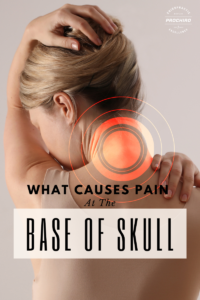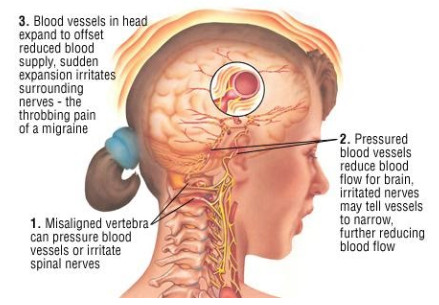Understanding the Agonizing Pain at the Base of Your Skull
Experiencing pain at the base of your skull can be an agonizing and debilitating sensation. Whether it manifests as a dull ache or a sharp, shooting pain, this discomfort can significantly impact your daily life and overall well-being. Understanding the causes behind this type of pain is crucial in finding relief and effectively managing its symptoms.
There are various factors that can contribute to the development of pain at the back or base of your skull. One common culprit is occipital neuralgia, a condition characterized by inflammation or irritation of the occipital nerves that run from the top of your spinal cord to the back of your head. This condition often leads to intense headaches localized at the back of the head.
Another potential cause is cervicogenic headache, which originates from issues in the cervical spine or neck region. This type of headache typically radiates from the neck towards the base of the skull, causing significant discomfort and restricted movement.
In this section, we will delve deeper into these conditions and explore their causes, symptoms, and available treatment options. By gaining a better understanding of what may be causing your skull pain, you can take proactive steps towards finding relief and improving your quality of life.
Pain in Back of Head at Base of Skull from Occipital Neuraligia
Occipital Neuralgia is a condition characterized by sharp, shooting pain in the back of the head at the base of the skull. This type of headache can be debilitating and significantly impact one’s quality of life.
Occipital Neuraligia Symptoms
Symptoms of Occipital Neuralgia may include intense pain that feels like an electric shock or stabbing sensation in the neck or base of the skull. Pain may also radiate to the scalp, forehead, or behind the eyes. Some individuals may experience sensitivity to light and sound as well.
Causes of Occipital Neuraligia
The causes of Occipital Neuralgia are diverse and can stem from various sources. These may encompass incidents like head trauma, the presence of tense muscles in the neck region, or even conditions like pinched nerves or underlying medical issues such as arthritis. It is essential to undergo proper testing and diagnosis methods to accurately pinpoint the occurrence of Occipital Neuralgia.
Testing and Diagnosis of Occipital Neuraligia
Diagnosis typically requires a meticulous physical examination carried out by a qualified healthcare professional to thoroughly assess symptoms and rule out any other potential causes for head pain. It is crucial to rely on the expertise of a trained professional to accurately pinpoint the underlying factors contributing to the discomfort experienced.
Your doctor may recommend an advanced imaging test, such as a Magnetic Resonance Imaging (MRI). This test can provide three-dimensional images of specific body structures, potentially revealing any impingement. Another option could be a Computed Tomography Scan (CT Scan), which helps visualize the shape and size of body structures. Additionally, some doctors might use occipital nerve blocks through injections to confirm their diagnosis. These procedures are all designed with your well-being in mind, aiming to provide the most accurate diagnosis possible for your condition.
When to Seek Medical Care for Occipital Neuraligia
In the event that you encounter persistent or severe pain at the back of your head, especially around the base of your skull, it is imperative to swiftly seek medical assistance without delay. A qualified healthcare provider possesses the expertise to accurately diagnose your condition and recommend appropriate courses of treatment. These may encompass a spectrum of interventions including medication, manual therapies including chiropractic treatment and physical therapy, nerve blocks, or other tailored treatments aimed at effectively managing and alleviating your symptoms.
Remember that early detection and management are key in addressing Occipital Neuralgia and improving your overall well-being. If you suspect you may have this condition or are concerned about your symptoms, do not hesitate to consult with a healthcare provider for proper evaluation and guidance on managing your pain.
Identifying the Main Triggers Behind Pain at the Base of the Skull
Pain at the base of the skull can be a debilitating condition that affects individuals in various ways. Identifying the main triggers behind this type of pain is crucial for effective management and treatment. Several factors can contribute to this pain, including neck tension, poor posture, muscle strain, stress and anxiety, and pinched nerves.
- Neck tension is a common culprit when it comes to back of skull pain. Prolonged periods of sitting or working in positions that strain the neck muscles can lead to discomfort and pain radiating towards the skull base. Poor posture also plays a significant role in exacerbating this type of pain. Slouching or hunching over for extended periods puts undue stress on the neck and surrounding muscles, leading to discomfort.
- Muscle strain is another factor that can trigger this type of pain at the base of the skull. Engaging in activities that involve repetitive movements or heavy lifting without proper form can strain the muscles in the neck and upper back region. This strain can cause referred pain to the skull base area.
- Stress and anxiety are known contributors to various types of bodily discomfort, including skull base pain. When individuals experience high levels of stress or anxiety, they often tense their muscles unconsciously, particularly those in the neck and shoulder region. This chronic muscle tension can lead to persistent pain.
- Additionally, a pinched nerve in the cervical spine can result in radiating pain towards the base of the skull. Nerves may become compressed due to spinal misalignment or herniated discs, causing discomfort that extends and travels beyond the neck area.
Identifying these common culprits behind skull base pain is essential for developing appropriate treatment plans and preventive measures. By addressing factors such as neck tension, poor posture, muscle strain, stress and anxiety levels, as well as potential nerve impingements through targeted therapies or lifestyle modifications, individuals experiencing this type of pain can find relief and improve their overall quality of life.
Surprising Factors that Could be Contributing to That Pain at the Base of Your Skull
While there are commonly known causes such as migraines or tension headaches, there are also some surprising factors that could be contributing to this discomfort. In this section, we will explore some of these silent saboteurs that may be responsible for your skull pain.
- One factor to consider is your sleeping position. The way you position your head and neck while sleeping can put strain on the muscles and joints in the skull base area, leading to pain and discomfort. Finding a supportive pillow and ensuring proper alignment of the spine during sleep can help alleviate this issue.
- Another potential culprit is eye strain from screens. With the increasing use of digital devices in our daily lives, prolonged exposure to screens can cause eye fatigue and strain. This strain can radiate to the skull area, resulting in pain. Taking regular breaks from screen time and practicing proper ergonomics when using electronic devices can help reduce this type of discomfort.
- Dehydration is another surprising factor that may contribute to pain at the back of your neck and into your skull. When our bodies lack adequate hydration, it can affect various systems, including those responsible for maintaining proper muscle function and joint lubrication. Dehydration may lead to muscle tension and stiffness around the skull base area, resulting in pain.
- TMJ disorder (temporomandibular joint disorder) is a condition affecting the jaw joint that connects the lower jawbone to the skull base. This disorder can cause pain not only in the jaw but also radiating up into the skull region. Issues such as teeth grinding or clenching, misalignment of the jaw joint, or arthritis can contribute to TMJ disorder-related skull pain.
- Lastly, upper cervical joint subluxation refers to misalignments and fixations of vertebrae in the upper neck region. These misalignments can put pressure on nerves and surrounding tissues, leading to referred pain felt at the skull base. Seeking specialized chiropractic care to address upper cervical joint subluxations may help alleviate this type of pain.
By understanding these surprising factors that could be contributing to your skull base pain, you can take proactive steps to address and manage your discomfort. It is always recommended to consult with a healthcare professional for an accurate diagnosis and personalized treatment plan based on your specific situation.
Treatment Options: Effective Strategies to Alleviate Skull Pain and Promote Healing
When it comes to treating skull base pain and promoting healing, there are several effective strategies and treatment options available. These include pain relief techniques, neck exercises, relaxation techniques, and chiropractic therapies.
For individuals experiencing skull base pain, various pain relief techniques can be beneficial. These may include over-the-counter pain medications or prescribed medication from a healthcare professional. Additionally, applying heat or cold packs to the affected area can help alleviate discomfort.
Neck exercises can also play a crucial role in relieving headaches associated with skull base pain. Stretching and strengthening exercises that target the neck muscles can help reduce tension and improve flexibility, leading to headache relief.
Incorporating relaxation techniques into one’s daily routine can be highly effective in reducing stress levels and alleviating skull base pain. Techniques such as deep breathing exercises, meditation, yoga, or mindfulness practices can promote relaxation and enhance overall well-being.
Chiropractic therapies have shown promise in providing relief for those suffering from pain at the base of the skull. Chiropractors may use manual adjustments or spinal manipulations to correct misalignments in the spine that could be contributing to the discomfort.
It is important to consult with a healthcare professional before starting any new treatment regimen for skull base pain. They will be able to assess your specific condition and recommend appropriate strategies tailored to your needs for effective pain relief and healing promotion.
—
How Do You Relieve Pain at the Base of the Skull?
Stretching exercises can help reduce tension in the neck and shoulders, which may alleviate pain at the base of the skull. Manual therapies such as massage or trigger point therapy can also be beneficial in reducing muscle tightness and discomfort in this area.
Chiropractic adjustments are known to effectively address pain at the base of the skull by realigning the spine and improving overall posture. Heat therapy, rest, and gentle massage can also provide relief by promoting relaxation and increasing blood flow to the affected area.
It’s important to consult with a healthcare professional before trying any new treatment or therapy, especially if you are experiencing chronic or severe pain at the base of your skull.
The Throbbing Pain at the Back of Your Head and Base of Your Skull May be a Migraine.
Many different patients come into Pro Chiropractic complaining of pain and throbbing at the base of their skull and back of the head. Many of these patients are students, have jobs working on computers, and spend a lot of time looking down. It is quite possible that the pain and tenderness you feel at the base of the skull and back of head may be a migraine! The prevalence of head pain and headaches has been increasing and we want to help decrease their effects and help people understand why they may be experiencing this pain.
What Is a Migraine?

It is pressure and a recurrent throbbing headache in the head that typically affects the back of the head and base of the skull. A migraine typically affects one side of the head (but it can affect both sides) and can be often accompanied by nausea, disturbed vision, and/or hearing. You may experience an aura, but an individual can still have a migraine without an aura as well. Migraines are usually debilitating and can interfere with you reading, focusing, doing homework, exercising, and even make your eyes and head sensitive to light.
What Causes a Migraine?
Now the golden question is what causes migraines? There are many different triggers in our lives that can cause them, but no matter the cause ultimately a migraine is a warning sign that there is an imbalance in the body. Your environment, past experiences, or traumas can
play a huge role in the tension, fascial adhesions or subluxations present in the body. A migraine is a result of physical, chemical, or emotional stress or interference in the bodies normal function. In our office we look at the physical problem, the misalignment of the neck bones, that can be a source of your migraines. One reason that “text neck,” computer work, looking down, or studying causes neck pain and/or headaches is due to the constant stress that looking down puts on your neck muscles and cervical spine. Getting into a car accident is also another factor that can cause stress on the neck and disrupt the alignment of the upper cervical and start causing someone to start experiencing migraine headaches.
The brain lacks pain receptors, but with the structural and muscle imbalance there can be inflammation and irritation of the nerves at the base of the skull and the trigeminal cranial nerve can be irritated and cause the throbbing pain on one side of the head and face.
There are a number of factors that can trigger migraines, including:
- Hormonal changes. Fluctuations in estrogen seem to trigger headaches in many women. Women with a history of migraines often report headaches immediately before or during their periods, when they have a major drop in estrogen.
- Foods. Aged cheeses, salty foods and processed foods may trigger migraines. Skipping meals or fasting also can trigger attacks.
- Food additives. The sweetener aspartame and the preservative monosodium glutamate (MSG), found in many foods, may trigger migraines.
- Drinks. Alcohol, especially wine, and highly caffeinated beverages may trigger migraines.
- Stress. Stress at work or school can cause migraines.
- Sensory stimuli. Bright lights and sun glare can induce migraines, as can loud sounds. Strong smells — including perfume, paint thinner, secondhand smoke and others — can trigger migraines in some people.
- Changes in wake-sleep pattern. Missing sleep or getting too much sleep may trigger migraines in some people, as can jet lag.
- Physical factors. Intense physical exertion, playing sports, accidents, or injuries may provoke migraines.
- Changes in the environment. A change of weather or barometric pressure can prompt a migraine.
- Medications. Oral contraceptives and vasodilators, such as nitroglycerin, can aggravate migraines.
What Can You Do If You Have a Migraine?
Using an over-the-counter medication may decrease the symptom short term but likely won’t take care of the actual problem, and prescription medication remedies are full of intense and scary side effects. If you are getting recurring pain at the base of your skull, that is a good indicator that there is underlying reason for your pain, and looking for the cause of your skull pain, rather than just trying to dull it with medication is a good idea. Consider getting checked for an upper cervical subluxation (misalignment) at your local chiropractor. The misalignment could be causing an increase in muscle tension and intracranial pressure causing that throbbing pain and soreness at the base of your skull. The intracranial pressure is controlled by the nerves, muscles, and bone structure at the base of the skull and there are small intricate muscles in this important area that tighten up when there is a misalignment in the neck and put pressure on the nerves at the base of the skull that wrap up and around the head.
Chiropractic Care May Help Migraine Pain
At Pro Chiropractic we help individuals release the physical tension that is put on the body by correcting upper neck fixation subluxations and the muscular trigger points and dense fascial adhesions that are also a common factor in causing migraine pain. We also take pride in helping people decrease the frequency and severity of their migraines through specific chiropractic analysis and care. If you are suffering from skull pain, let us know and we would like to eliminate your migraines and headaches all together. In our office we can also evaluate the structure and function of your spine through a thorough evaluation, advanced diagnostics and digital x-rays. If you have any further questions or concerns about the pain in the back of your skull, and if this may be migraine headache pain you are experiencing don’t hesitate to ask for help. Our chiropractors are specialists in helping resolve the pain safely and effectively.
Pro Chiropractic Bozeman
2405 W Main St, Ste 8
Bozeman, MT 59718
Call: 406-219-2462
Mon-Fri: 7am-11am & 2pm-6pm
Sat 8am-11am
Pro Chiropractic Belgrade
8757 Jackrabbit Ln, Ste A
Belgrade, MT 59714
Mon-Tue-Thu-Fri: 7am-11am & 2pm-6pm
Closed Wed

New Patients | Treatments | Specialties | About | Blog
